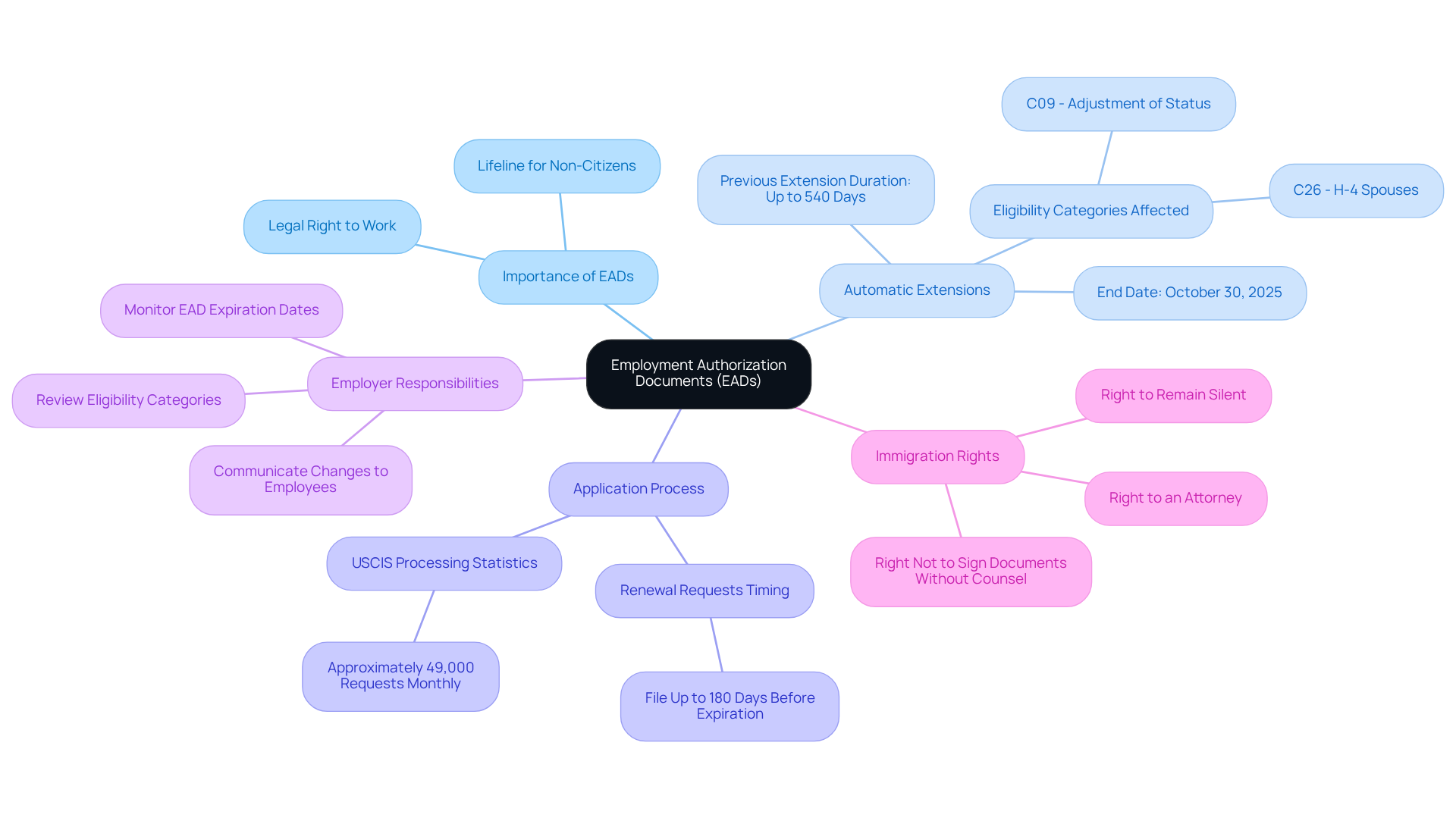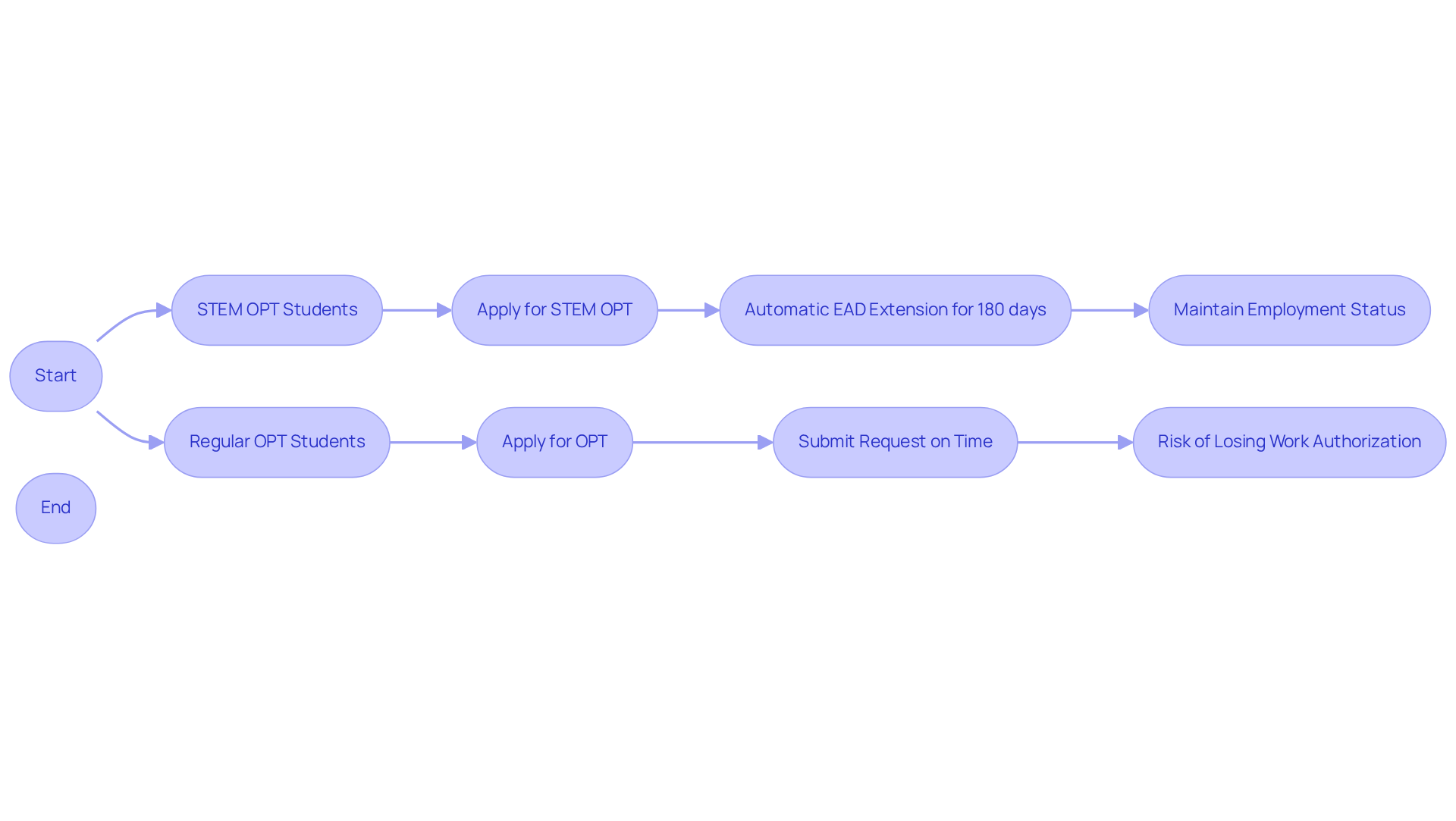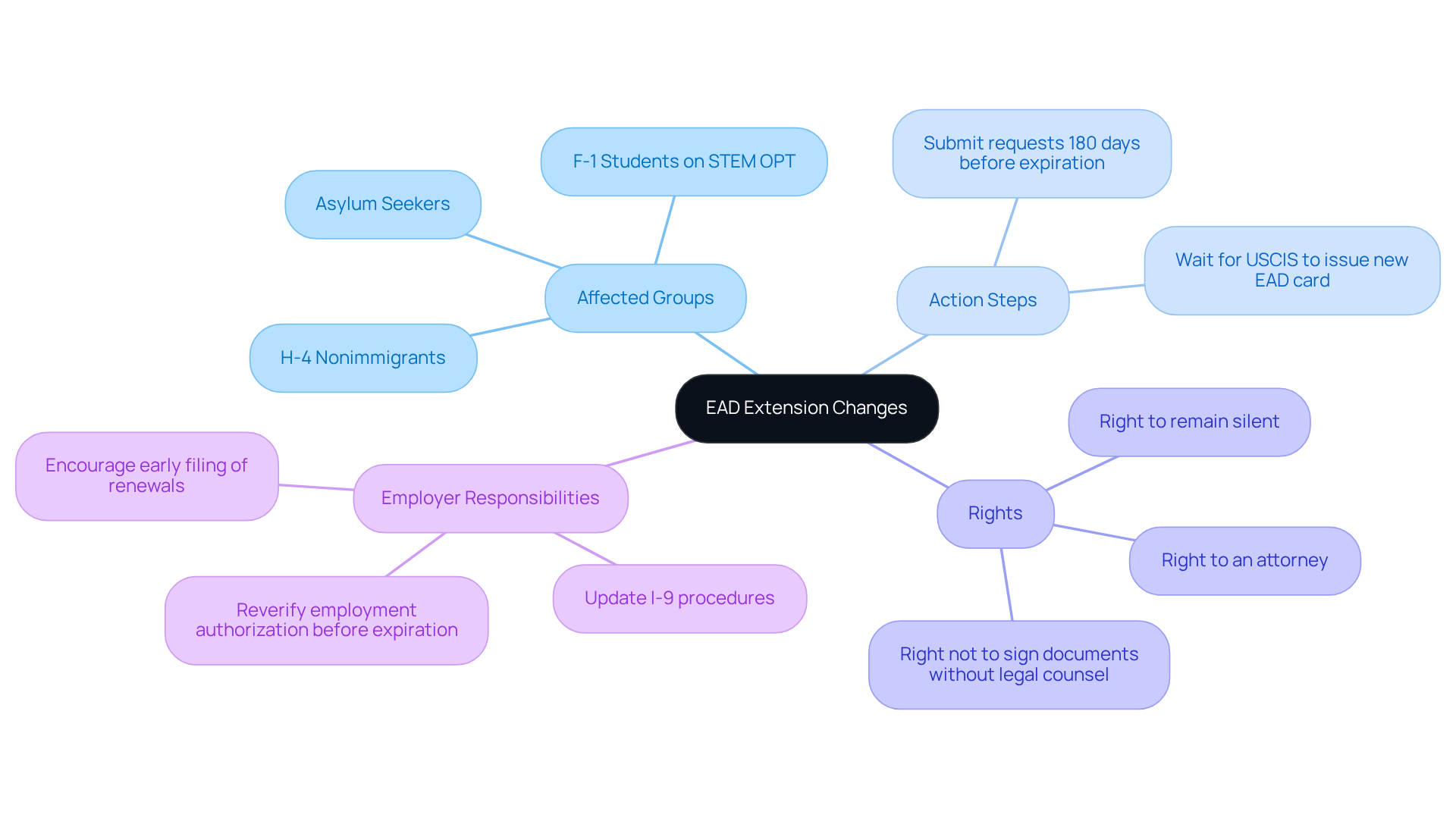Introduction
The landscape of Employment Authorization Documents (EADs) is changing rapidly, with major shifts set to take effect on October 30, 2025. For non-citizens, EADs are crucial for securing the legal right to work in the U.S. However, the recent decision to eliminate the automatic extension for most renewal requests raises serious concerns about employment continuity.
Have you ever felt anxious about your work status? This article dives into the implications of these changes, offering insights on how applicants can navigate the new regulations to avoid gaps in work authorization. It’s important to know that you have rights, even when the system feels overwhelming.
So, how can individuals and employers prepare for this new reality? What steps should they take to ensure uninterrupted employment? We’re here to fight for your family and help you find clarity in this moment of uncertainty.
Define Employment Authorization Documents and Automatic Extensions
Employment Authorization Documents (EADs) are essential for non-citizens in the U.S. They provide the legal right to work for a specific period, and they’re issued by the U.S. Citizenship and Immigration Services (USCIS). For many, EADs are a lifeline in the complex world of employment.
Have you ever felt lost in the immigration process? Automatic extension of EAD used to be a safety net for those who applied for reissuance before their current EAD expired. This meant you could keep your job while waiting for processing-up to 540 days! But significant changes are on the horizon. As of October 30, 2025, the automatic extension of EAD will no longer be available for most renewal requests. This means both employers and employees need to take proactive steps to ensure continuous work authorization.
Workers should submit requests for EAD extensions up to 180 days before their current EAD expires. This is crucial to avoid any interruptions in employment. Last year, USCIS processed around 49,000 EAD requests each month. This highlights the need for timely updates and awareness of the new regulations.
Employers, it’s time to talk to your foreign national employees about these changes. Review eligibility categories like C09 and C26, which will no longer qualify for the automatic extension of EAD. This is vital to prevent compliance issues.
In case of immigration emergencies, remember your rights:
- You have the right to remain silent.
- You have the right to an attorney.
- You have the right not to sign documents without legal counsel.
We’re here to fight for your family and ensure you understand your rights. Your future matters to us.

Examine DHS Changes to Automatic EAD Extensions
Effective October 30, 2025, the Department of Homeland Security (DHS) has officially ended the automatic prolongation of Employment Authorization Documents (EADs) for reauthorization requests. This change means that if you submit a renewal request on or after this date, you won’t benefit from the automatic extension that used to allow you to keep working while waiting for your application to be processed. To avoid any gaps in your employment authorization, it’s crucial to file your renewal applications well in advance - ideally up to 180 days before your current EAD expires.
Why is this happening? The DHS is committed to improving the vetting and screening processes for EAD applicants. This shift is expected to lead to more thorough background checks, enhancing public safety and national security. The policy of automatic extension of EAD was initially introduced to fill work authorization gaps caused by processing delays, but it has evolved over time, recently extending from 180 days to 540 days. Now, the new rule underscores that maintaining work authorization is a privilege that requires timely action from applicants.
If you hold an EAD based on Adjustment of Status requests or are an H-4 dependent of an H-1B spouse, you’ll likely feel the impact of this change. Immigration attorneys are urging applicants to take a proactive approach to ensure they don’t face interruptions in their employment. As attorney M. Alejandra Vargas puts it, "It is crucial for applicants to understand the new requirements and act promptly to avoid any gaps in their work authorization."
In light of these changes, it’s essential to stay informed and seek legal guidance to navigate these complexities effectively. At Vasquez Law Firm, we offer free consultations and 24/7 emergency support for personal injury cases, ensuring you have immediate access to legal assistance when you need it. Remember, you must have a newly approved EAD or another valid work authorization to continue working after your current EAD expires. If you find yourself in an urgent legal situation, know that you have rights and can reach out to Vasquez Law Firm for support.
Your future matters to us. We’re here to fight for your family. Yo Peleo - We Fight.

Clarify Impact on F-1 OPT and STEM OPT Students
Recent changes to Employment Authorization Document (EAD) regulations, effective October 30, 2025, bring significant challenges for F-1 students, particularly those applying for STEM OPT renewals. These students will benefit from an automatic extension of EAD for 180 days while their work authorization applications are pending. This ensures they can maintain their employment status during this crucial time.
In contrast, F-1 students on regular OPT need to be especially vigilant about submitting their requests on time. Without the automatic extension of EAD, they risk losing their work authorization if they miss strict deadlines. Understanding this difference is vital as students explore job opportunities after graduation, especially since thousands of F-1 students seek STEM OPT extensions each year.
Educational institutions emphasize the importance of timely EAD updates to preserve legal work status. It’s crucial to note that F-1 students with pending STEM OPT requests are not covered by the new regulation, which can lead to confusion.
We understand how overwhelming this feels. But remember, you’re not alone in this fight. Stay informed, act promptly, and know that we’re here to support you every step of the way.

Summarize Key Takeaways from the EAD Extension Changes
The recent changes to the automatic extension of EAD are significant and deserve your attention. Starting October 30, 2025, automatic prolongations for EAD reapplications will no longer be available. This shift affects many, including H-4 nonimmigrants and asylum seekers, who will now need to navigate this process without the safety net of automatic extension of EAD.
Have you ever felt overwhelmed by the immigration process? It’s crucial to act now. Applicants are encouraged to submit their requests up to 180 days before their current EAD expires. This proactive step is vital to avoid gaps in work authorization. Remember, you must wait for USCIS to issue a new EAD card before you can resume work. Missing this window could lead to serious employment authorization gaps, impacting your livelihood.
For F-1 students on STEM Optional Practical Training (OPT), there’s a silver lining: you’ll still benefit from the automatic extension of EAD for 180 days while waiting for your STEM EAD application approval. This provision is essential for maintaining your work status during the renewal process, so timely filing is key.
In light of these changes, it’s essential for immigrant healthcare workers to know their rights and the immediate steps to take if faced with a subpoena or immigration enforcement. If you find yourself in a legal emergency, remember:
- You have the right to remain silent.
- You have the right to an attorney.
- You have the right not to sign documents without legal counsel.
Don’t hesitate to reach out to Vasquez Law Firm for urgent legal assistance. We’re here to ensure your rights and freedom are protected.
Employers, too, may feel the strain of these new requirements. It’s vital for both applicants and employers to stay informed and proactive. Your future matters to us, and together, we can navigate these challenges.

Conclusion
The recent changes to the automatic extension of Employment Authorization Documents (EADs) signal a crucial shift in work authorization for non-citizens in the U.S. Starting October 30, 2025, the elimination of automatic extensions means that both employees and employers need to adapt quickly to new protocols to ensure uninterrupted employment. This update highlights the importance of timely action and awareness in navigating the complexities of immigration regulations.
Have you ever felt overwhelmed by the immigration process? Workers must now submit renewal requests up to 180 days before their current EAD expires to avoid any gaps in work authorization. While specific groups, like F-1 students on STEM OPT, will still enjoy a limited automatic extension, it’s vital to remain vigilant and file promptly. Employers, too, play a key role in this transition, engaging with their foreign national employees to ensure compliance with the new regulations.
Understanding these changes is essential for maintaining work status and protecting rights within the employment framework. It’s important to know you have rights, even if others tell you otherwise. All affected individuals should stay informed and proactive, seeking legal guidance when necessary. By taking these steps, both employees and employers can navigate the evolving immigration landscape effectively, ensuring a bright and secure future for everyone involved.
We’re here to fight for your family. Your future matters to us. Yo Peleo - We Fight.
Frequently Asked Questions
What are Employment Authorization Documents (EADs)?
Employment Authorization Documents (EADs) are issued by the U.S. Citizenship and Immigration Services (USCIS) and provide non-citizens in the U.S. with the legal right to work for a specific period.
What was the purpose of the automatic extension of EADs?
The automatic extension of EADs allowed individuals who applied for reissuance before their current EAD expired to continue working while waiting for processing, for up to 540 days.
When will the automatic extension of EADs no longer be available?
As of October 30, 2025, the automatic extension of EAD will no longer be available for most renewal requests.
What should workers do to avoid interruptions in employment regarding EADs?
Workers should submit requests for EAD extensions up to 180 days before their current EAD expires to avoid any interruptions in employment.
How many EAD requests does USCIS process each month?
Last year, USCIS processed around 49,000 EAD requests each month.
What should employers do in light of the changes to EAD automatic extensions?
Employers should discuss these changes with their foreign national employees and review eligibility categories like C09 and C26, which will no longer qualify for the automatic extension of EAD.
What rights do individuals have in case of immigration emergencies?
Individuals have the right to remain silent, the right to an attorney, and the right not to sign documents without legal counsel.




